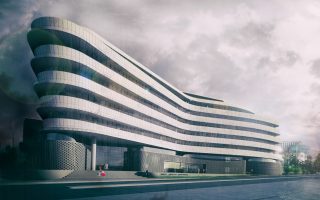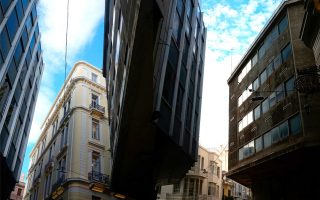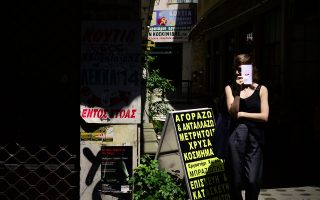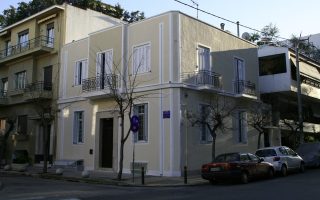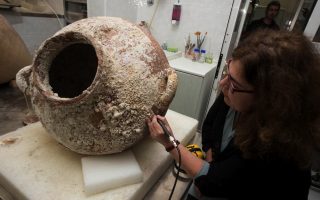The silent sentries of the Academy of Athens

They may see everything from their lofty vantage point, but how many of us passers-by can say we’ve given them more than a passing glance? Some 18 meters above the ground, in a manbasket suspended from a crane and in the company of monument restorer and civil engineer Gerasimos Thomas, I was able to get a close-up look at all the mythical figures on the splendid main pediment of the Academy of Athens, on the theme of the birth of Athena.
When they were placed there in 1875 by sculptor Leonidas Drosis, the building overlooking what is today on Panepistimiou Street had not been yet completed. In the 140 years since, those figures have silently observed the evolution of Athens from a city with a population of just a few thousand to the present-day Greek capital of more than 6 million residents. They have survived wars and upheavals, and all the ups and downs of modern Greek history. The figures they depict may be ageless, immortal, but their sculpted bodies are not immune to the ravages of time: from the veins that seem to pulsate on the arms of Zeus, father of the gods, to Athena’s dainty toes peeking out of her sandals.
For near on a century and a half, they have been tended by conservationists only occasionally, despite their daily battle against time, the elements and pollution. Hephaestus has proven the most vulnerable, with parts of his marble legs appearing torn, as he stands with hammer in hand after cracking Zeus’ head to release the armored Athena.
Thomas, who is also a painter, takes measurements, examines the marble and makes a careful sketch of the figure, capturing the details of the damage so that a suitable approach to its repair can be found.
“The first thing we need to check is the sculpture’s structural integrity and any small cracks,” he says.
The sculptor conceived Hephaestus in a bold pose, with his back turned, meaning that his balance is not centered and he is less firmly positioned than the other sculptures. The composition is inspired by the Parthenon’s West Pediment, while the Academy’s architectural style reflects elements from the Erechtheion.
It’s 7 o’clock on a Tuesday morning and the sun is casting it’s early light on the faces of Drosis’s other wonderful sculptures, Athena and Apollo, standing atop marble columns while the details on the capitals shine blue, red and gold after being recently refreshed by the conservators of the Athens Technical College.
“The first time a restoration was attempted was in the 1980s. The complete project for the restoration of the Academy took place in three stages during the 2003-08 period with funding of around 4.5 million euros from the Third Community Support Framework,” explains architect Dora Papadimitriou, who has been overseeing the work on behalf of the Academy, under the supervision of academic Antonis Kounadis.
“The first phase concerned the roof, which was damaged after a beam collapsed. The second was for the marble elements in the building’s interior and on its exterior and the third was for the paintings on the exterior,” she says.
“The more we got to know the structure, the more we realized that a lot more needed to be done on it,” says Papadimitriou. “The second cycle of work started in 2010 and received 1.8 million euros in public funding. It was aimed at sealing the building’s exterior, restoring the interior painted decorative elements and also restoring the eight peripheral terra-cotta pediments that were constructed not by Drosis but by Polish sculptor Franz Melnitzky. Certain marble elements were removed, such as figures and the anthemia, so that copies could be made.”
The work is almost finished but, says Papadimitriou, “now we will have to start all over again because such buildings need constant care.”
The serene grandeur of the building is more apparent from up high than it is from street level. Work started on the Academy, designed by Theophil Hansen under the supervision of Ernst Ziller, in 1859 and was completed, as part of a magnificent trilogy along with the National Library and Athens University, 26 years later in 1885. However, it did not house the Academy of Athens until 1926, shortly after the institution was established. The building itself is considered among the most beautiful examples of neoclassical architecture in the world, particularly for the harmony of its scale in relation to the city and man. Perhaps surprisingly, few Athenians have ventured inside even though it is open to the public, the general secretary of the Athens Academy, Vassileios Petrakis, assures as he shows us into his office.
“There are also organized tours, at least for those who really care about the building, as there are quite a few who have even tried to destroy it: Some protesters once tried to set the door on fire, lamps have been smashed and pieces of the marble exterior have been chipped off. Every protest rally comes past this spot. As far as graffiti is concerned, the temporary sheet metal fence has protected the building and will not come off until peace is restored – which means we don’t know when. We have made successive appeals to the state about the problem with drug addicts. In the past five years, three have died of overdoses in the courtyard and you see people using and selling drugs right next to the building every day. Unfortunately, our appeals go unheeded. It seems that we may be in constant contact with the ancients in here, but can’t get through to our contemporaries.”
Sculptor Praxitelis Tzanoulinos remembers first entering the building with one of his teachers, academic Yiannis Pappas. “A marble plaque had collapsed in the conference room. ‘Listen to the building,’ my teacher told me. ‘It is angry and asking for help.’”
Tzanoulinos is one of the experts on the team, which also comprises chemical engineer Vassilis Lambropoulos, who studied and recommended the cleaning agents used, the conservators of the Athens Technical College, Amalia Gousi, the on-site supervisor, and Giorgos Pavlopoulos, who was responsible for overseeing the painted decor.
“Buildings are like sculptures. They need tender human care to remain standing. And they give back the love they receive while remaining open to the world. So, the Academy, which was scarred by time, is now a glowing edifice that gives us the strength to get through these difficult times,” says Tzanoulinos.
